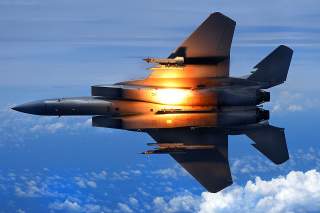The Typhoon Fighter: Europe’s Very Own F-15EX?
The F-35 crowd won't like this one bit.
The U.S. Air Force created a stir when it asked for a billion dollars this year to buy eight F-15EXs, the heavily modernized version of the legendary Cold War fighter. Despite the U.S. military going all in to make the fifth-generation F-35 its primary aircraft, the fact that the Air Force wants at least a few fourth-generation F-15s as a possible replacement for its aging F-15C air superiority fighters.
But Europe is also upgrading its current Eurofighter Typhoon to remain viable for decades to come. And just like the F-35 vs F-15EX, this raises the question of whether a fourth-generation aircraft will undercut plans to buy expensive fifth-generation models.
Last month’s Paris Air Show showed a mockup of what a European sixth-generation fighter, meant to replace the Typhoon, might look like in the 2040s (Britain is independently developing its own sixth-generation fighter, the Tempest). But until the Future Combat Air System is ready, Europe needs a modern fighter that can hold its own against the latest Russian models for at least the next 20 years. That’s where an upgraded Typhoon comes in. First introduced in 2003, it is considered a “4.5-generation” aircraft, a category that also includes America’s F-18E/F Super Hornet and F-16E/F Block 60s, Russia’s Su-35, France’s Rafale and China’s J-10. These are fourth-generation – or late Cold War – designs that have been upgraded with advanced features such as AESA radar, tactical datalinks, thrust vectoring maneuverability, and sophisticated munitions.
NATO and several European defense contractors announced at the air show that they had signed a $54 million agreement to study extensive upgrades to the Typhoon.
The 19-month Long Term Evolution study “will underpin the future of Eurofighter by identifying a suite of technology enhancements for the weapons system infrastructure and the engine that will ensure the aircraft remains operationally effective and can continue to spearhead the Partner Nations’ air forces for the decades to come,” according to British defense firm BAE.
The study will focus on upgrading the Typhoon in five areas:
- Enhanced performance for the fighter’s EJ200 engine. “The focus is on four key areas: thrust growth; range and persistence with increased parts life; survivability as well as control system enhancements,” BAE said.
- Advanced multi-spectral sensors as well as high-speed tactical datalinks to network with offboard sensors and other platforms.
- Better defensive systems to counter new threats to the Typhoon.
- More electrical power and cooling capacity to carry advanced weapons.
- Panoramic cockpit displays.
“Together with further life extension measures and the development of a future maintenance strategy based on in-service experience, the LTE contracts are the first step towards ensuring that Eurofighter’s combat strength can be maintained and fully exploited throughout the first half of the 21st century,” said Clemens Linden, CEO of Typhoon contractor Eurojet.
The F-15EX, derived from advanced F-15s flown by foreign users such as Saudi Arabia, has better radar, avionics and defensive sensors than the F-15C. Yet it also has 70 percent parts commonality with the F-15C and F-15E. While somewhat cheaper than the F-35, at $80 million each versus $100 million for the Lightning II, the real advantage is that the Air Force already has the training, parts and facilities to quickly adapt the F-15EX.
Nonetheless, the F-15EX is essentially a spiffed-up fourth generation fighter, as is the Typhoon. Both planes would lack the features of a fifth-generation aircraft, such as sensor fusion. And, of course, they would not have the stealth configuration and components of an F-35 or a European sixth-generation fighter – if European nations are willing to spend the money for it.
Michael Peck is a contributing writer for the National Interest. He can be found on Twitter and Facebook.

